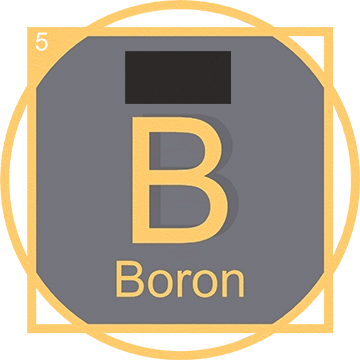Boron (B): An Essential Chemical Element in Science
Discover the fascinating world of Boron, from its discovery to its versatile applications in modern technology and science.
Introduction to Boron
Boron is a fascinating element with the atomic number 5 and is represented by the symbol B. It is a non-metallic element located in group 13 of the periodic table, playing a crucial role in the chemical makeup of various compounds.
Discovery of Boron

Boron was first discovered in the early 19th century, around 1808, by chemists Joseph Louis Gay-Lussac and Louis Jacques Thénard and independently by Sir Humphry Davy. These scientists were able to isolate boron by combining boric acid with potassium. This discovery opened up new pathways in the field of chemistry and material science.
Properties of Boron
Boron is unique for its hardness and high melting point, making it ideal for high-strength materials. It exists in various allotropes, but the most common are amorphous Boron, a brown powder, and crystalline Boron, which is black and extremely hard, second only to diamond in hardness.
Role of Boron in the Periodic Table and Science
In the periodic table, Boron is positioned in the p-block and is part of the metalloids, a group of elements with properties in between metals and non-metals. This positioning is critical as it influences how Boron reacts chemically and physically with other elements and compounds. In science, Boron is vital for creating boron-containing compounds used in heat-resistant materials and in the production of glass and ceramics.

Applications of Boron
Boron has a wide array of applications in everyday life and in advanced technology sectors. It is crucial in the manufacture of borosilicate glass which is resistant to thermal shock. Boron fibers are used in aerospace structures for their light weight and high strength. Moreover, Boron compounds play a critical role in agriculture as micronutrients in plant growth.
Conclusion
Boron continues to be a topic of research and development, with new applications being discovered that utilize its unique properties. Understanding Boron's role not only enriches our knowledge of chemistry but also enhances our capability to innovate in technology and sustainable solutions.
How Boron is Produced
Boron is not found free in nature; instead, it occurs combined in borates or boron minerals. The most common extraction method is through the mining of borate minerals such as borax (sodium tetraborate) and kernite. These minerals are processed through either physical or chemical methods to extract boric acid, which is then further refined into boron.

Major Boron Mines and Associated Resources
Boron is primarily mined from large scale borate deposits in the United States and Turkey, which are among the largest suppliers of the element. Important mines include:
- Kern County, California – The largest boron mine in the world, also known for yielding minerals like calcite and ulexite.
- Eskişehir Province, Turkey – Known for substantial borate deposits and associated minerals such as colemanite and ulexite.
- Antofagasta de la Sierra is another area of Boron in Catamarca of Argentina.
Common resources found alongside boron in these mines include calcium in the form of calcite and sodium in halite.

Modern Uses of Boron
Today, Boron is indispensable in various industries and applications:
- Glass and Ceramics: Boron is used to make borosilicate glass, which is resistant to thermal shock and strong chemicals, making it ideal for laboratory glassware and cookware.
- Agriculture: Boron compounds are essential micronutrients in agriculture, promoting healthy growth of plants.
- Detergents and Bleaches: Borates and perborates are components of many household cleaning products.
- High-tech Applications: Boron fibers are used in aerospace materials for their incredible strength and light weight.
The Future of Boron in Science and Technology

The future potential of Boron is vast with ongoing research into its properties and new applications. Innovations include:
- Boron Neutron Capture Therapy (BNCT): A cutting-edge cancer treatment technique that uses boron-10 to destroy cancer cells without harming surrounding healthy cells.
- Energy Storage: Boron is being explored for use in battery technologies to improve efficiency and capacity, particularly in the development of green energy solutions.
- Superhard Materials: Research is underway to utilize Boron in creating materials harder than diamonds, which could revolutionize industrial cutting and drilling technologies.











